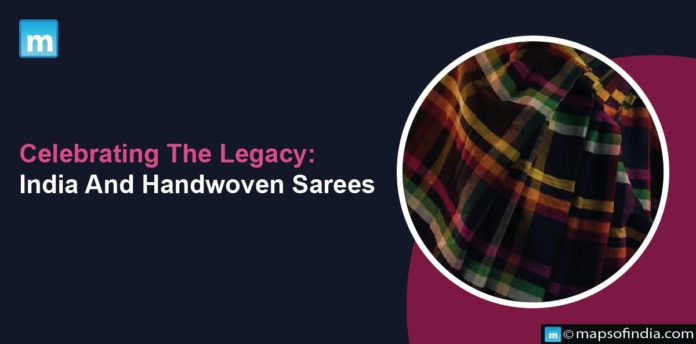The golden bird flapping its tri-colored wings has a vast wind of legacy and long heritage within its fold. One such legacy is tied to the drapes of the handloom industries of India.
Background
The celebration of National Handloom Day was first inaugurated in 2015 by the Government of India, designating August 7 as the day of observance for the same. The day is a tribute to the heritage of Indian handloom and its artisans who have kept the art alive for so long. Originally, the day is also a reminiscence of the Swadeshi Movement that happened on the day back in 1905.
Handloom saris
The beauty and exquisiteness of handloom saris cannot be comprehended by threading a few words of appreciation. The mesmerizing factor about the industry is its rich diversity. Indian states have unique collections of fortes, techniques, designs, fabrics, and twists for handloom saris that make them stand out and sink in simultaneously.
Kanjeevaram of Tamil Nadu
Kanjeevaram is named after the small town in Tamil Nadu, Kanchipuram, and is known for its delicate and durable quality of silk. The unique traits of these saris lie in the brightness and vibrancy of their colour. The zari, sewn into the saris, is of the utmost high quality and usually woven in gold and silver materials.
Banarasi silk of Varanasi
Of the various delicacies from the traditional aisles of Banaras, Banarasi silk sari rules the handloom sari industry. The Banarasi silk is deemed one of the finest in India, with its brocade woven carefully in gold and silver materials and opulent embroidery, making it a must in every closet in Banaras and beyond.
Chanderi of Madhya Pradesh
Hailing from Chanderi in Madhya Pradesh, Chanderi sarees are a staple of every woman in the tribal state and others. The materials invested in making these sarees are pure silk, cotton, and zari. They are unique for their beautiful prints, excellent quality, and luster. Traditional coins, peacocks, geometrics, and floral motifs are some of the most popular patterns that can be spotted in the Chanderi sarees.
Paithini of Maharashtra
The Paithini sarees hail from the Paithan town in Aurangabad. The features and designs on the saree are inspired by the abode of mother nature, a display of flora and fauna with trees, parrots, and peacock painted on the drapes of the saree.
Bhagalpur of Bihar
Created in the town of Bhagalpur in Bihar, the Bhagalpuri sarees are popular for using unique tussar silk. The shine and grandeur of the saree make it one of India’s finest textured silk saree.
Bandhini of Gujarat
Tie-dye tees and shirts that recently gained vogue should not be mistaken for a solely Westernized tradition. The artisans in Gujarat have been practicing it for ages now. The Bandhini saree is made with the tie-dye technique of manually plucking the cloth finely into multiple tiny bindings forming an abstract style. The Khatri community of Gujarat was the forerunner of this print. However, these sarees are also popular in the regions of Punjab and Rajasthan.




